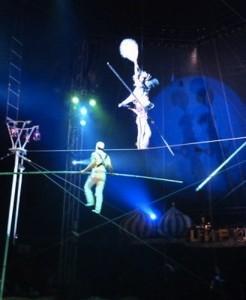Creativity will save the world.
To business leaders, this means more than just creating new works of art or Pulitzer Prize winning literature. The global economy depends upon people and businesses thinking differently, according to Jonah Lehrer, author of Imagine.
This sentiment mirrors Apple’s famous “Think Different” ad, which included many “traditionally” creative writers and artists, like John Lennon, Alfred Hitchcock, Pablo Picasso, and Jim Henson.
Apple, though, looked beyond the Kermit the Frogs of the world to exceptional scientists, business people, and political leaders—people who managed to “think differently about something we do everyday”—such as Albert Einstein, Thomas Edison, Mahatma Gandhi, and Martin Luther King, Jr.
Clearly, the world of arts and literature has no monopoly on creativity. What then, defines creativity? For Steve Jobs (via his marketing copywriters) it meant:
- being crazy / a misfit / a rebel / a troublemaker / a round peg in a square hole
- seeing things differently
- ignoring the rules and the status quo
- inventing / imagining / healing / exploring / creating / inspiring
- pushing the human race forward.
Looking at that list, you quickly realize that creativity is no small task. Not only is the future of the human race resting on your shoulders, but you also have to do it while being mocked and ridiculed by your peers. This is the image of Kermit the Frog enduring endless jokes about his spindly, green legs, but still being able to “get things started.”
For inspiration, the business world naturally turned to the writers, artists, and musicians of the world. These people create for a living, so their methods should rescue the economy from its current innovative black hole. The creative right brain, say proponents, is the way forward for a world long dominated by too much rational leftedness.
Unlike the right brain, the left side deals in concrete details, deadlines, and doing things perfectly. This latter obsession with perfectionism, left unchecked, eventually turns half of your brain into a more vocal critic than the real people in your life. As Julia Cameron, author of Finding Water: The Art of Perseverance (Artist’s Way),describes it, “The critic does not believe in creative glee—or any glee at all, for that matter. No, perfectionism is a serious matter.”
 One way to free your creativity, says Betty Edwards, author of Drawing on the Right Side of the Brain, is by “suppressing” the left side. You accomplish this by developing the right side independently until it’s strong enough to stand up to the mocking that comes from the other hemisphere. It’s like lifting weights. If your right arm is dominant—and stronger—you have to throw some extra work at the left arm until it’s an equal match.
One way to free your creativity, says Betty Edwards, author of Drawing on the Right Side of the Brain, is by “suppressing” the left side. You accomplish this by developing the right side independently until it’s strong enough to stand up to the mocking that comes from the other hemisphere. It’s like lifting weights. If your right arm is dominant—and stronger—you have to throw some extra work at the left arm until it’s an equal match.
Humans may be bilaterally symmetrical creatures—with two eyes, arms, legs, and brain hemispheres—but the world is not really a binary system. Republicans and Democrats, black and white, and good and evil are all arbitrary divisions. Accepting these kinds of clichés is the worst mistake that a writer or artist can make.
The way toward creativity, then, has little to do with one side of the brain or other, or the business world versus the artists. Albert Einstein probably didn’t divide his work into left and right. He created, analyzed, and joked, switching between these many states according to the situation.
As Carl Jung puts it, “Wholeness is not achieved by cutting off a portion of one’s being, but by integration of the contraries.” This is the essence of finding your creativity. You think differently not by ignoring part of yourself, but by finding balance, by embracing the myriad personalities floating around inside your mind. If you are a writer, this also extends to the characters that populate your complex inner landscape.
Sometimes, though, in order to begin the process, you have to step out of the role that you are most firmly grounded in. Like the Ents, the giant talking and walking trees of J.R.R. Tolkien’s The Lord of the Rings, you have to uproot yourself from what is familiar and begin the long journey toward saving the human race.
This is what Joseph Campbell calls the Hero’s Journey, a cycle common to many myths—ancient and modern—that has as much relevance to modern creators as it did to primitive hunters visiting a cave bear altar. The journey always begins with a Call to Adventure, a sign that it’s time to leave the minimally satisfying, yet comfortable, safety of the Village, in order to enter the Dark Forest.
Apple’s “Think Different” ads highlighted this first step. Leaving the village involves ignoring the rules. The forest is forbidden, as are most strange and unfamiliar things. When you enter that unknown realm, you immediately hear the taunts of the other villagers—“you’re crazy” or “what a troublemaker”—as they try to convince you to embrace the status quo.
If you keep walking, though, those voices will fade in time, replaced by the new sights and sounds that can only be found on your own path. Once you start creating—and healing—your inner “critic” will also stop talking, giving your left brain the space and clarity it needs to join the right brain in this new adventure.
__________
Photo: Copyright sylvia duckworth and licensed for reuse under this Creative Commons License


